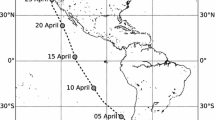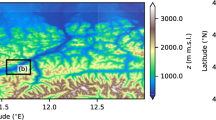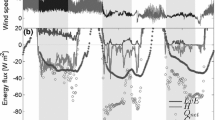Abstract
The Hilbert–Huang transform (HHT) is applied to analyzing the turbulent time series obtained within the atmospheric boundary layer over the ocean. A method based on the HHT is introduced to reduce the influence of non-turbulent motions on the eddy-covariance based flux by removing non-turbulent modes from the time series. The scale dependence of the flux is examined and a gap mode is identified to distinguish between turbulent modes and non-turbulent modes. To examine the effectiveness of this method it is compared with three conventional methods (block average, moving-window average, and multi-resolution decomposition). The data used are from three sonic anemometers installed on a moored buoy at about 6, 4 and 2.7 m height above the sea surface. For each method, along-wind and cross-wind momentum fluxes and sensible heat fluxes at the three heights are calculated. According to the assumption of a constant-flux layer, there should be no significant difference between the fluxes at the three heights. The results show that the fluxes calculated using HHT exhibit a smaller difference and higher correlation than the other methods. These results support the successful application of HHT to the estimation of air-sea turbulent fluxes.






Similar content being viewed by others
References
Acevedo OC, Moraes OLL, Fitzjarrald DR, Sakai RK, Mahrt L (2007) Turbulent carbon exchange in very stable conditions. Boundary-Layer Meteorol 125(1):49–61
Fairall CW, Bradley EF, Hare JE, Grachev AA, Edson JB (2003) Bulk parameterization of air-sea fluxes: updates and verification for the COARE algorithm. J Clim 16(4):571–591
Hong J, Kim J, Ishikawa H, Ma Y (2010) Surface layer similarity in the nocturnal boundary layer: the application of Hilbert–Huang transform. Biogeosciences 7(4):1271–1278
Huang NE, Shen Z, Long SR, Wu MLC, Shih HH, Zheng QN, Yen NC, Tung CC, Liu HH (1998) The empirical mode decomposition and the Hilbert spectrum for nonlinear and non-stationary time series analysis. Proc R Soc Lond A 454(1971):903–995
Huang NE, Wu ZH (2008) A review on Hilbert–Huang transform: method and its applications to geophysical studies. Rev Geophys 46(2) RG2006. doi: 10.1029/2007RG000228
Huang YS, Song JB, Fan CH (2012) A motion correction on direct estimations of air-sea fluxes from a buoy. Acta Oceanol Sin (in press)
Huang YX, Schmitt FG, Lu ZM, Liu YL (2008) An amplitude-frequency study of turbulent scaling intermittency using empirical mode decomposition and Hilbert spectral analysis. Europhys Lett 84(2):40010. doi:10.1209/0295-5075/84/40010
Mahrt L (2010) Computing turbulent fluxes near the surface: needed improvements. Agric For Meteorol 150(4):501–509
Mahrt L, Moore E, Vickers D, Jensen NO (2001) Dependence of turbulent and mesoscale velocity variances on scale and stability. J Appl Meteorol 40(3):628–641
Miller SD, Hristov TS, Edson JB, Friehe CA (2008) Platform motion effects on measurements of turbulence and air-sea exchange over the open ocean. J Atmos Ocean Technol 25(9):1683–1694
Rannik U, Vesala T (1999) Autoregressive filtering versus linear detrending in estimation of fluxes by the eddy covariance method. Boundary-Layer Meteorol 91(2):259–280
Sakai RK, Fitzjarrald DR, Moore KE (2001) Importance of low-frequency contributions to eddy fluxes observed over rough surfaces. J Appl Meteorol 40(12):2178–2192
Vickers D, Mahrt L (1997) Quality control and flux sampling problems for tower and aircraft data. J Atmos Ocean Technol 14(3):512–526
Vickers D, Mahrt L (2003) The cospectral gap and turbulent flux calculations. J Atmos Ocean Technol 20(5):660–672
Vickers D, Mahrt L (2006) A solution for flux contamination by mesoscale motions with very weak turbulence. Boundary-Layer Meteorol 118(3):431–447
Vincent C, Giebel G, Pinson P, Madsen H (2010) Resolving nonstationary spectral information in wind velocity time series using the Hilbert–Huang transform. J Appl Meteorol Climatol 49(2):253–267
Acknowledgments
This research was supported by the National Basic Research Program of China (Nos. 2011CB403501 and 2012CB417402), National Natural Science Foundation of China (No. 41176016), and the Open Research Foundation for the Key Laboratory of Ocean Circulation and Waves, Chinese Academy of Science (KLOCAW1207).
Author information
Authors and Affiliations
Corresponding author
Rights and permissions
About this article
Cite this article
Wang, J., Song, J., Huang, Y. et al. Application of the Hilbert–Huang Transform to the Estimation of Air-Sea Turbulent Fluxes. Boundary-Layer Meteorol 147, 553–568 (2013). https://doi.org/10.1007/s10546-012-9784-8
Received:
Accepted:
Published:
Issue Date:
DOI: https://doi.org/10.1007/s10546-012-9784-8




